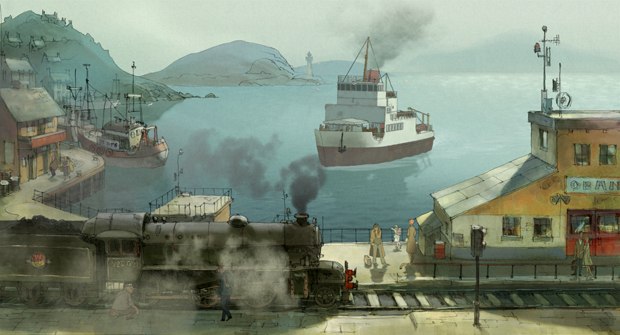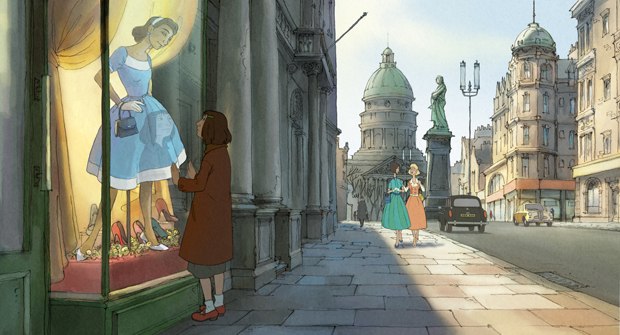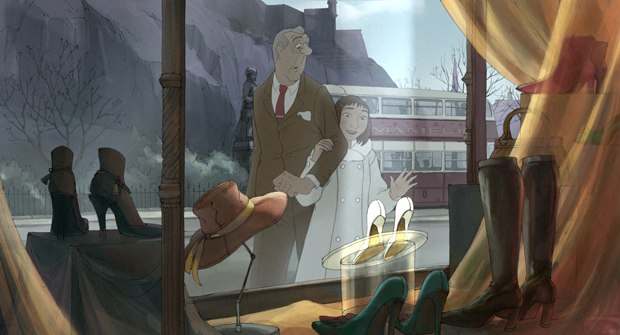Sylvain Chomet gives AWN an exclusive glimpse into the world of his latest animated feature where Tati meets Scotland.
Check out The Illusionist clips at AWNtv!
After paying direct homage to Jacques Tati in his acclaimed The Triplets of Belleville, it was serendipitous for Sylvain Chomet to tackle the unproduced Tati script, The Illusionist, about an elderly magician and young girl who reach new emotional depths together. Chomet was so taken with Scotland after presenting The Triplets of Belleville at the Edinburgh Film Festival that he decided to move there and set up a studio, Django Films. He discusses the making of The Illusionist (opening Christmas Day through Sony Pictures Classics), which has been shortlisted for an Oscar nomination and nominated for a Golden Globe.
Bill Desowitz: They often say what can be done in live action should not be animated, but The Illusionist is certainly an exception.
Sylvain Chomet: It could have been done as a live-action by Tati, but actually he couldn't play the magic show himself because of an accident with his left hand. He was longing to do the trick, but he couldn't do it and that's the reason he didn't do the film. But then when I was contacted by his daughter [Sophie Tatischeff], she didn't want someone else to do the role -- she didn't want it to be a live-action film. She thought that animation was the only way to do the film and could bring something very tangible and some real emotion. It's the reason I wanted to do the film. And also I thought that it was a big challenge for animation and I like big challenges. Yes, you're right: We should just animate what we can't do in live action, but I haven't seen many films like this in animation as well. And probably the only way to revise Jacques Tati in this film was through animation.
BD: Changing the location to Scotland, where you were already living, was probably the biggest aesthetic change. What was that like?
SC: For me it was easier to make this a bit more personal as well -- a bit more real by changing the location from Prague to Edinburgh because I thought there were a lot of elements in the scenery in Scotland which were really quite close to the story, especially the change of light and mystery. Scotland is a place of mystery, of magical legends and things like that. At the same time, I don't like to invent places, you know. I prefer to sketch what I'm watching and I was in Scotland at that time, so I was inside the backgrounds. And Edinburgh is a very important character.
BD: Yes, as you say, it evokes many things visually and thematically. It's on the cusp of change.
SC: It's 1959, and there was something that needed to be done on the streets. We needed to have a bright city and showing some nice shops and nice windows, and, at the same time, in some very remote places where they just had electricity.
BD: There's something very reminiscent of 101 Dalmatians. Talk about the design and color palette.
SC: Yes, I'd been working with a Danish art director [Bjarne Hansen] and basically the Danish have the same kind of light as Scotland -- and he was perfect to recreate the very difficult Northern lights. And we used the same technique on 101 Dalmatians: basically hand-drawn backgrounds and then color it in Photoshop or Painter. At the same time, I wanted the backgrounds to come to life: I wanted to feel the air, to feel the wind and the change of lights when the clouds are passing on the mountains. We used Digital Fusion on top of the gorgeous backgrounds he's made. It's not made for animation, but it's such a great tool. We managed to actually bring some atmosphere to the backgrounds. And if you take the DVD and accelerate it, you can actually see how much the lights are changing. You can feel how much more dramatic the light scenes are in the film. Even if you are inside your apartment, the light coming in is always changing. With animation, you can change everything: you can change the weather. To film in live action in Scotland is a nightmare because the lights change all the time.
BD: What was it like animating the magician and the girl and all the performers?
SC: Well, we had one Spanish animator who was just in charge of The Illusionist on stage, and another animator was in charge of the day to day life of the character when he was in the city. And they worked with other animators who had scenes with assistants and in-betweeners. And for the young girl there was just one main animator and a lot of secondary animators. And then for some of the other characters, I always tried to keep one character per animator because sometimes the character varies too much and we don't recognize him. As you know, 2D animation is a very long process because you first have to learn to draw the character and then how they're going to move, so after two years he will know the character by heart. And after a while, the animators know the characters better than I do and they try some different things which I wasn't thinking of.
BD: What about maintaining the Tati style without close-ups or moving camera?
SC: It was challenging and caused us a lot of difficulties -- you have some very long shots where it's difficult in animation to follow a character walking round. And you are farther away from the characters.
BD: You have to work harder to create a sense of intimacy?
SC: Well, yes, but animation doesn't just work with the expression on the face but with the body language, and it's more like the theater. It makes it for very natural relations, also.
BD: What was the most difficult story challenge?
SC: To establish Jacques Tati straight away in the film: to recognize him but at the same time make him strikingly different from his other films. More melancholy. When I read his script, I had a strong feeling of something very strong and very moving about him. In a way, it's a different experience, I suppose, for people seeing the film. I really wanted to go more toward the cinema that Tati had been doing; that the Japanese directors did, which is something gentler. And of course, we are in a very aggressive period right now with 3-D and you can do whatever you want with the camera. But because the film is talking about the musical, I did something to make it feel a bit like a musical.
BD: The transition from the music hall to rock 'n' roll is analogous to the transition from 2D to 3D in animation. Was that intentional?
SC: No, I wasn't thinking at all about that at the time. But then now I can see the resemblance. And the resemblance is something very simple: I thought that with the live performance you could take the whole family, and then there was an end to it and they appealed to the teenager. And now is it the same with animation? I don't know. They are making more and more things with animation. But I really liked WALL•E, which is a really well directed film and you can really see that the vision of the future is very political and very dark and I thought that was amazing.
BD: What are you doing next?
SC: I'm going to try live action: one is a musical and one is a bit more fantasy.
BD: What are you most excited about in trying live action?
SC: Well, the thing is in animation you're used to being in control of everything. The only thing in live action is that you have to give the actors some freedom. Of course, in live action there is a realization you have to establish between the director and the actors. But it is very interesting because I bring a love and a very lively way of shooting. It takes too much time to do an animated film, especially in 2D. You need a lot of patience and I don't have any patience, which is my nightmare. And sometimes you need a change in life, so we'll see.
Bill Desowitz is senior editor of AWN & VFXWorld.











